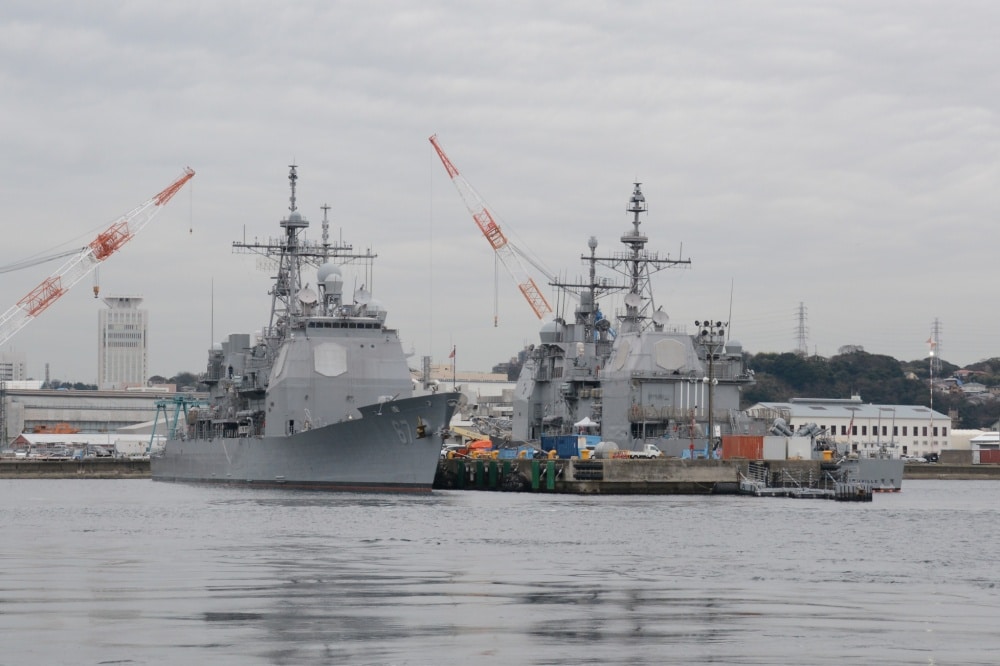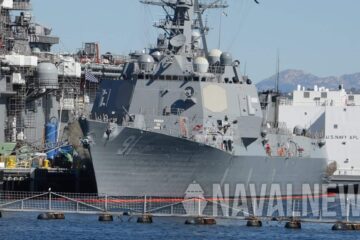According to SEAPOWER 2021 Almanac, all five of the Baseline 1 twin-arm (Mk 26 missile launcher) cruisers have been decommissioned in 2004 and 2005, leaving the remaining ships armed with Vertical Launch System (VLS) cells. Each cruiser has two 61-cell Mk 41 VLSs for a total of 122 missiles per cruiser, and there is concern that retirement would also reduce the missile cell count in a Carrier Strike Group and the fleet if new ships aren’t built to replace the cruisers.
In the 2013 budget request, Congress declined to approve the retirement of four selected cruisers, USS Anzio, USS Vicksburg, USS Port Royal, and USS Cowpens, and another three ships in 2014, the USS Gettysburg, the USS Chosin, and the USS Hue City. Congress also refused the Navy’s plan to pull out the 11 newest cruisers for modernization and retire the 11 oldest. Also according to SEAPOWER, Congress did approve a cruiser modernization program for the seven cruisers named above in 2015 to improve their readiness, address material condition, replace obsolete equipment, and introduce new warfighting capabilities.
At the Sea Air Space 2021’s virtual Prequel on July 20, 2021, U.S. Navy’s Chief of Naval Operations (CNO), Admiral Michael M. Gilday, explained the reasons for the retirement of seven of the oldest AEGIS radar cruisers from the active fleet to save money by divesting in Legacy ships.
“So the most controversial [topic] is the cruisers. There are seven proposed decommissionings in the FY22 budget and the argument I made falls across three areas: First is the cost to own and operate which is about $5 billion over the five-year defense plan. The second is reliability and these ships on average are about 32-years old. We’re seeing cracks and we’re seeing challenges in the material conditions of these ships that are a certain degree unpredictable so they’re `unknown unknowns.’ [such as fuel tank cracks that recalled a cruiser twice on deployment back to homeport]. And the third is Lethality. Some of these cruisers have the SPY-1A [AEGIS] radar which is an analog system; others are early SPY-1Bs. They’re approaching obsolescence, Number One, and Number Two, they have difficulty seeing the threat based on the speed and profiles of the threat missiles we see flying these days. The cost alone for cruiser modernization is running tens of millions of dollars above what we originally estimated largely due to the unknowns related to hulls that are over three decades old.”
CNO Admiral Gilday

The U.S. Navy believes that the money saved from the divestment of the seven Ticonderoga cruisers will go towards funding modernization programs and new shipbuilding efforts.
“If I can talk about it in three dimensions: on the sea, in the sea, and in the air. All of the Virginia-class [submarines] Block 3s and 4s should be delivered by 2025. On the sea we’ll just be at the cusp of delivering the first Constellation-class frigate and we’ll be delivering the DDG [Arleigh Burke] Flight IIIs in earnest and we’re investing in a longer-range weapon, the Maritime Strike Tomahawk. And lastly, by 2025, I believe if we stay on path, we’ll be delivering the Zumwalt-class destroyers with a Hypersonic missile capability. In the air, half of our airwings will have a Fourth and Fifth Generation mix, which analysis has shown to be quite effective against our adversaries, and tied to that is a longer-range surface-to- air missile which gives us greater reach and greater punch.”
CNO Admiral Gilday






